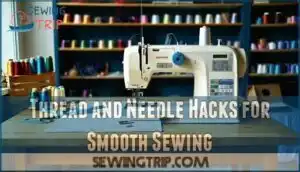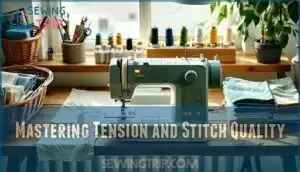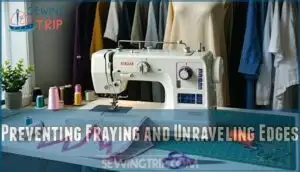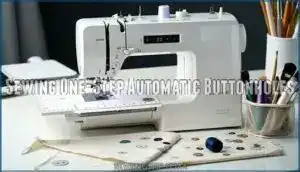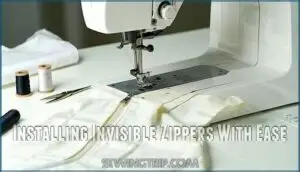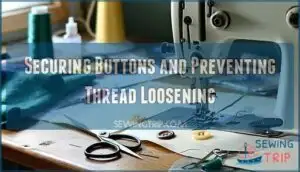This site is supported by our readers. We may earn a commission, at no cost to you, if you purchase through links.
 Your sewing machine doesn’t have to fight you. When tension pulls threads into knots, fabric bunches where it should glide, or seams pucker after you’ve sewn them perfectly straight, the problem isn’t your skill—it’s missing the small adjustments that separate frustrating projects from satisfying ones.
Your sewing machine doesn’t have to fight you. When tension pulls threads into knots, fabric bunches where it should glide, or seams pucker after you’ve sewn them perfectly straight, the problem isn’t your skill—it’s missing the small adjustments that separate frustrating projects from satisfying ones.
Most sewers never learn the quick fixes professionals use daily: the soap bar trick that makes pins slide through thick fabric, the plastic bag method for crossing bulky seams, or the thirty-second tension test that prevents hours of seam ripping.
These automatic sewing tips and tricks transform your machine from an unpredictable tool into a reliable partner that manages any fabric you feed it.
Table Of Contents
- Key Takeaways
- Essential Sewing Tools for Automatic Machines
- Preparing Fabric for Flawless Results
- Thread and Needle Hacks for Smooth Sewing
- Mastering Tension and Stitch Quality
- Preventing Fraying and Unraveling Edges
- Sewing Elastic, Gathers, and Drawstrings
- Sewing Buttons, Zippers, and Buttonholes
- Handling Difficult Fabrics and Tricky Areas
- Organizing Your Sewing Space Efficiently
- Quick Fixes and Advanced Sewing Shortcuts
- Frequently Asked Questions (FAQs)
- Conclusion
Key Takeaways
- Most sewing frustrations stem from skipping small adjustments like tension tests, proper threading, and fabric prep—not from lack of skill—and fixing these basics prevents hours of seam ripping.
- Simple tools and tricks transform difficult tasks: wax strengthens thread, plastic bags help glide over thick seams, bodkins thread elastic in seconds, and pinking shears plus zigzag stitches stop fraying instantly.
- Matching your machine settings to fabric type—adjusting tension for lightweight versus heavy materials, choosing the right needle, and selecting appropriate stitches—separates professional results from amateur mistakes.
- Smart workspace organization with pegboards, labeled storage, and tools within arm’s reach eliminates wasted time hunting for supplies and keeps your workflow smooth from start to finish.
Essential Sewing Tools for Automatic Machines
Your automatic sewing machine is only as good as the tools you pair it with. The right equipment transforms frustrating projects into smooth, professional results.
Let’s look at the essentials that’ll keep your workspace sharp and your workflow uninterrupted.
Choosing Quality Scissors and Keeping Them Sharp
Your scissors are the unsung heroes of your sewing toolkit—keep them sharp by cutting fabric only, never paper or pins, and they’ll slice through cloth like butter for years to come. Here’s how to maintain that razor-sharp edge:
- Dedicate one pair exclusively to fabric—paper dulls blades fast
- Store them in a protective case to preserve cutting precision
- Get professional blade sharpening annually for peak performance
- Test your scissors on scrap fabric regularly to catch dullness early
Organizing Pins and Needles Efficiently
A magnetized dish keeps pins from staging their great escape across your sewing table, and a steel wool–stuffed pin cushion actually sharpens your needles while they wait.
Store your pins in small plastic bags or hang them on a pegboard for instant access. Keep a bar of soap nearby—slide pins into it to organize them and add smooth glide.
These sewing tools and accessories transform chaotic needle storage into smooth thread control for beginners and pros alike.
Must-Have Sewing Accessories (Bodkin, Measuring Tape, Etc.)
Beyond pins and needles, every sewing machine setup needs sewing notions that deliver precision. A bodkin—that slim 3–4 inch metal tool—cuts elastic threading time in half. Flexible measuring tapes (60 inches standard) prevent fit errors that plague 18% of home projects.
Add these five sewing aids:
- Needle threaders to slash threading time by 60%
- Fabric markers (water-soluble) used in 95% of projects
- Thread conditioners (wax) to strengthen hand-sewing thread
- Seam rippers present in 95% of kits
- Thread snips for 1–2mm precision cuts
These sewing tools and accessories turn your machine into a powerhouse. For precise thread cutting, consider using thread snips tools to achieve professional results.
Preparing Fabric for Flawless Results
Your fabric prep work sets the foundation for every stitch that follows. Get this part right, and you’ll skip the headaches that come from shrinking seams, slipping scissors, and crooked cuts.
Here’s what you need to know to prep like a pro.
Pre-Washing and Shrinkage Prevention
Nothing derails a finished project faster than fabric that shrinks the first time it hits the wash—so let’s make sure that never happens to you. Pre-washing is your insurance policy against fabric shrinkage. Throw your textile into the machine before you cut a single piece—it’s the difference between garment stability and disaster.
| Fabric Type | Pre-Washing Method |
|---|---|
| Cotton | Hot water wash, tumble dry |
| Linen | Warm wash, air dry flat |
| Wool | Cold gentle cycle, reshape |
| Synthetics | Cool wash, low heat dry |
This fiber care step locks in your sewing efforts and protects every thread you stitch.
Cutting Techniques for Slippery Fabrics
Slippery fabrics like satin and silk fight you at every cut—but you can win. Pin your fabric to muslin underneath to slash shifting by over 50%. Reach for a rotary cutter instead of scissors; it delivers 25% more accurate cuts on synthetics. Cut one layer at a time using long, smooth strokes to prevent jagged edges. Pattern weights beat pins for even pressure without marks, boosting accuracy by 30%.
Keep your cutting tools sharp and your sewing machine ready—grain alignment starts here. To master cutting slippery fabrics, understanding cutting techniques is essential for achieving professional results.
Marking and Finding The Grain Line
Finding the grain line isn’t guesswork—it’s the difference between a garment that drapes like a dream and one that twists off your body. Master fabric orientation with these steps:
- Clip the selvage edge and pull a loose thread
- Align your pattern parallel to the exposed thread line
- Mark the grainline with soap for cutting accuracy
This fabric manipulation technique ensures your sewing machine handles properly aligned pieces every time.
Thread and Needle Hacks for Smooth Sewing
Your thread and needles can make or break a project. A few simple tricks will keep your stitches smooth and your sewing flowing without frustration.
Let’s look at three quick hacks that solve the most common thread and needle problems.
Strengthening Thread With Wax
When you’re hand sewing through tough fabric or working with delicate thread that keeps snapping, a little beeswax can be your secret weapon. Run your thread across the wax block once or twice before you start stitching. This simple trick strengthens the thread and prevents fraying.
| Thread Type | Wax Application | Benefit |
|---|---|---|
| Cotton Thread | Light single pass | Adds sewing durability without stiffness |
| Embroidery Thread | Gentle double pass | Protects delicate fibers from breakage |
| Heavy-Duty Thread | Firm coating | Provides thread reinforcement and needle protection |
Your sewing machine might not need this hack, but for hand sewing techniques, waxed thread glides through fabric like butter and gives you fray prevention that lasts.
Preventing Thread Breakage
Thread breakage in the middle of a project can turn a smooth sewing session into a frustrating stop-and-start battle—but it’s almost always preventable if you know what’s causing it.
Check your thread tension first—too tight strains the yarn strength and snaps it instantly. Use a fresh, sharp needle to reduce fabric friction, and double up delicate metallic thread with regular thread for breakage prevention.
Clean your sewing machine regularly, and you’ll master thread management without the headaches.
Using Hairspray for Easy Needle Threading
If you’ve ever squinted, twisted, and cursed while trying to thread a needle, a quick spritz of hairspray changes everything. Lightly coat the thread tip, let it stiffen for a second, and watch it slide straight through the eye—no more fraying or frustration.
This simple needle threading hack beats fancy threading tools and works as well as any thread conditioner or needle lubricant you’ll find in stores.
Mastering Tension and Stitch Quality
Tension control isn’t just about turning a dial—it’s what separates clean, professional seams from frustrating tangles and puckers. Getting your settings right transforms how your machine manages each fabric and stitch.
Here’s what you need to know to nail tension and stitch quality every time.
Adjusting Tension for Different Fabrics
Tension control separates smooth, professional seams from puckered disasters that scream amateur hour. Your sewing machine needs different thread tension based on what you’re stitching—lightweight silks demand finesse, while heavyweight denim requires muscle. Here’s how to nail it every time:
- Lightweight fabrics: Lower your thread tension slightly to prevent puckering and adjust stitch length for delicate weaves
- Medium-weight cotton: Start with your machine’s default tension setting and test on fabric scraps first
- Heavy denim or canvas: Increase tension and use a longer stitch length to manage thick layers without thread breakage
- Stretch knits: Reduce tension and use a ballpoint needle to accommodate fabric stretch without snapping threads
- Slippery synthetics: Fine-tune both upper and bobbin tension while testing on sample pieces
Master these sewing tips and you’ll transform tension headaches into impeccable stitches.
Using The Right Stitch for Each Project
Picking the wrong stitch is like showing up to a knife fight with a butter knife—you need the right tool for the job. Straight stitches manage woven fabrics and basic seams, while zigzag stitches tackle knits and seam finishing.
Your sewing machine offers specialized options—stretch stitches for activewear, triple stitches for stress points, and overlock stitches that mimic serger results.
Match your stitch selection to fabric weight and project demands, then pair it with proper thread choice and tension control for bulletproof seams.
Preventing Fraying and Unraveling Edges
Fraying edges can unravel your hard work before you even finish a project. You’ve got three solid techniques that stop fabric from falling apart at the seams.
Let’s break down how pinking shears, zigzag stitches, and stay stitching keep your edges locked in place.
Using Pinking Shears and Zigzag Stitches
Fraying edges are the silent saboteurs of every sewing project, but you can stop them in their tracks with two simple weapons. Pinking shears create a zigzag cut that naturally resists unraveling, while a zigzag stitch locks down raw edges with precision.
5 Ways to Master Fraying Prevention:
- Cut fabric with pinking shears immediately after cutting your pattern pieces for instant edge binding
- Set your sewing machine to a medium-width zigzag stitch for effective seam finishing
- Combine both methods on delicate fabrics that need extra fabric stabilization
- Run zigzag stitches along all raw edges before assembling your project for stitch reinforcement
- Test your sewing techniques on fabric scraps to find the perfect tension and width
Applying Stay Stitching to Seams
Stay stitching is your insurance policy against stretched-out necklines and warped curves—a single line of straight stitches sewn just inside the seam allowance that locks your fabric’s shape in place before you start construction.
Apply it to curved edges immediately after cutting with your scissors for maximum seam security. Use a regular stitch length on your sewing machine and sew in the direction of the grain for fabric stability.
This sewing technique provides edge finishing and seam reinforcement that prevents distortion during manipulation—essential stitch prevention for bias-cut pieces.
Reinforcing Delicate Fabrics
Delicate fabrics like silk, chiffon, and lace demand extra support—interfacing, stabilizer, or tissue paper underneath can prevent puckering and tearing when your machine’s presser foot applies pressure. Interfacing techniques provide essential fabric stabilization for reinforced seams.
Choose lightweight tear-away stabilizer for silk management and delicate hemming. Your sewing machine delivers smooth results when you support fragile materials with proper fabric reinforcement—that’s the difference between professional-looking sewing techniques and frayed disasters.
Sewing Elastic, Gathers, and Drawstrings
Elastic, gathers, and drawstrings can make or break your project—but only if you know how to manage them right. These elements add flexibility and shape to waistbands, cuffs, and sleeves, giving your garments the fit they need.
Here’s how to master each technique without the usual headaches.
Inserting Elastic With a Bodkin
A bodkin is your secret weapon for wrestling elastic through casings without losing your mind. This simple tool clips onto the elastic end, giving you control as you weave through fabric casings and channel stitching.
Just pin the other end of the elastic before you start—that prevents it from disappearing into the tunnel. Your sewing machine creates the casing, but the bodkin finishes the job with zero frustration.
Creating Gathers Using a Corded Zig-Zag
If you’ve ever fumbled with basting stitches for gathering, this corded zig-zag trick will feel like breaking free from sewing jail. Set your sewing machine to a wide zig zag stitch, then stitch over a piece of cord or dental floss without catching it.
Pull the cord to create perfect gathers with total fabric manipulation control—no broken threads, no uneven bunching. Lock it down with a straight stitch, and you’ve mastered gathering fabric like a pro.
Retrieving Lost Drawstrings Easily
When your drawstring vanishes into a waistband or hood, don’t waste time wrestling with safety pins—grab a bodkin and reclaim control in seconds.
This string finder tool makes drawstring retrieval and cord management simple. Just attach the elastic cord to the bodkin’s clasp, feed it through the channel, and weave your way to victory.
These sewing hacks beat fumbling with thread or makeshift tools for drawstring replacement every time.
Sewing Buttons, Zippers, and Buttonholes
Buttonholes, zippers, and buttons can make or break your garment’s professional finish.
Your automatic machine has built-in features that turn these tricky closures into straightforward tasks once you know the right approach.
Here’s how to manage each one with confidence.
Sewing One-Step Automatic Buttonholes
Your automatic sewing machine just made buttonholes ridiculously simple—no more measuring, marking, or wrestling with multiple passes. Select the automatic buttonhole stitch, slide your button into the foot’s measurement guide, and let the machine manage the precision.
Check your thread tension before starting—it’s the difference between buttonhole mastery and frayed edges. Align your fabric, hit the pedal, and watch your sewing machine deliver impeccable results every time.
Installing Invisible Zippers With Ease
Invisible zippers disappear into your seams—but only with the right zipper foot and proper alignment. Swap your standard foot for a universal zipper foot, then unroll the zipper coils and press them flat. Position the teeth directly under the foot’s groove for zipper alignment and sewing precision.
Stitch close to the coils using an invisible stitch technique, letting fabric guidance keep everything straight.
Your sewing machine and serger tips say: baste first, then sew with confidence using these essential sewing tools and techniques.
Securing Buttons and Preventing Thread Loosening
Loose buttons don’t stand a chance when you lock them down with clear nail polish. Dab a tiny drop on the thread center after sewing—it seals the knot and stops unraveling cold.
This thread locking trick doubles as button reinforcement without bulky fabric adhesives. You’re using sewing stabilizers and fray prevention in one move.
That’s button security that lasts, plus a smart addition to your sewing machine and serger tips arsenal.
Handling Difficult Fabrics and Tricky Areas
Some fabrics fight you at every turn, and thick seams can stop your machine cold. You don’t have to avoid these challenges—you just need the right moves to manage them.
Here’s how to tackle the trickiest parts of any project without breaking your stride.
Sewing Over Lumpy or Thick Seams
Thick seams don’t have to stop your machine cold—there’s a simple trick to glide right over them without broken needles or skipped stitches. Here are five heavy duty sewing techniques that’ll help you master lumpy fabric solutions:
- Place a plastic bag over the bulky area so your presser foot glides smoothly
- Use a scrap of equal thickness behind the foot to level it out
- Walk the needle through manually using the handwheel
- Adjust presser foot pressure for better control
- Switch to a jeans needle for extra strength
These sewing hacks transform frustrating seam smoothing techniques into shortcuts even sewing for beginners can nail.
Turning Thin Projects Right Side Out
Skinny straps and narrow tubes can feel impossible to flip, but a simple chopstick-and-straw combo makes the job simple. Thread the straw through your sewn tube, push the chopstick inside, and gently roll the fabric back over itself—these right side techniques give you complete control over delicate seam management.
This thin fabric manipulation method beats wrestling with tiny spaces, turning tricky sewing tube methods into sewing shortcuts that work every time.
Gliding Over Problem Areas With Plastic Bags
Once you’ve conquered narrow tubes, bulky seams and thick layers throw a different challenge your way—but a thin plastic bag slipped under your presser foot turns those bumpy spots into smooth sailing.
The bag reduces fabric slippage and gives you glide control over lumpy fabrics, letting your sewing machine manage thick intersections without stalling.
This sewing hack transforms frustrating moments into smooth stitching—no special sewing aids required, just a simple shortcut that puts you back in command.
Organizing Your Sewing Space Efficiently
A chaotic sewing space kills your momentum before you even start. When your tools are scattered and your fabric’s buried under a pile of scraps, you waste time hunting instead of creating.
Let’s set up smart storage solutions that keep everything within reach and your workflow running smooth.
Using Pegboards and Thread Organizers
A chaotic sewing space is like trying to cook in a kitchen where you can’t find the spatula—pegboards and thread organizers turn that mess into a command center where everything’s within arm’s reach.
Mount a pegboard above your sewing station to hang scissors, rulers, and tools you grab constantly. Use a thread organizer or dowel rods to line up spools by color—no more digging through boxes when you’re mid-project and need the perfect shade.
Storing Fabric and Buttons for Easy Access
Stashing fabric in a file cabinet with measuring guides taped to the drawers lets you pull and cut without hunting for a ruler, while button collections stay tame in small plastic bags clipped to a wire rack. Label everything by color or project type so your sewing station stays sharp.
Smart fabric storage and button organization mean less time weaving through clutter and more time creating—that’s fabric folding that actually works for your sewing room organization.
Keeping Scissors and Tools Handy
Hang your scissors on a necklace cord around your neck or mount a magnetic strip beside your machine so you never waste thirty seconds digging through fabric scraps again.
Keep these sewing tools within arm’s reach:
- Rotary cutter on a pegboard hook for instant fabric cuts
- Seam ripper clipped to your machine for quick fixes
- Thread snips in a cup beside your foot pedal
- Measuring tape attached to your table edge with command strips
- Pin cushion weighted with steel wool for sharpener tips that keep needles ready
Storage solutions that put scissors and crafting tools where you need them transform sewing room organization from chaos to control.
Quick Fixes and Advanced Sewing Shortcuts
You’ve mastered the basics—now it’s time to take control of those last-minute fixes and pro-level shortcuts that separate confident sewers from frustrated ones.
These techniques will help you rescue garments, speed up your workflow, and keep your machine running like new.
Let’s break down the moves that’ll give you total command over your projects.
Adjusting Waistbands and Hems Fast
When your favorite jeans won’t button or your hem droops like a wilted flower, you don’t need a complete overhaul—just a fast sewing hack that gets you back in action.
For waistband adjustments, add elastic loops at the button for instant expansion or take in the side seams for a snugger fit.
Hemming techniques like blind stitches or quick machine hems save time while keeping garment alterations professional-looking and durable.
Preventing Runs and Extending Garment Life
Runs don’t have to spell the end of your hard work. Edge finishing with zigzag stitches cuts fraying by 60%, while fabric sealants like Fray Check slash thread shedding by over 85%. Reinforce stress points with double stitching to boost garment longevity by 38%.
Use fusible interfacing for fabric reinforcement and stay stitching on curves to lock in shape through dozens of washes—smart seam strengthening that keeps your creations looking sharp.
Cleaning and Maintaining Your Sewing Machine
Your sewing machine works hard for you—treat it right with regular cleaning, and it’ll deliver smooth stitches for years. Use canned air or sewing machine brushes for dust removal methods after every project.
Apply machine oil tips quarterly to moving parts, and follow regular maintenance schedules. Clean your bobbin case with cleaning solvent options, keep thread management tight, and you’ll master sewing machine maintenance like a pro.
Frequently Asked Questions (FAQs)
How to get better at machine sewing?
Practice transforms thread into mastery. Focus on Machine Maintenance, consistent Sewing Speed, and smart Fabric Selection.
Master Thread Management and Stitch Control through repetition. Each seam teaches Sophisticated Sewing Techniques that enhance your craft.
What are some advanced sewing techniques?
Master fabric manipulation and garment construction techniques like setting invisible zippers, perfecting tension control, and exploring textile artistry through sophisticated quilting.
Contemporary sewing innovations demand precision in embellishments and weaving intricate details that enhance every project beyond basic stitching.
What not to do with a sewing machine?
Never force your machine past its limits—fabric jamming, needle breakage, and tension mismatch happen when you skip proper threading, overload layers, or rush without testing.
These sewing techniques protect both your project and equipment.
What’s the hardest thing to sew?
Think of delicate fabrics like silk as ice skating—one wrong move and you’re down. Stretchy materials, thin seams, curved hems, and intricate embroidery top the hardest-to-sew list, demanding precision and expert sewing techniques to master garment construction.
How do you prevent thread nests under fabric?
Thread tension issues cause most nests below fabric. Check your bobbin management first—rethread both top and bobbin, ensuring correct threading paths. Adjust thread tension settings, verify needle choice matches fabric weight, and confirm proper stitch length.
Clean lint from the bobbin area regularly using these essential sewing techniques.
What tension setting works best for thick materials?
For Heavy Duty Sewing and Thick Fabric Tips, increase your tension setting slightly—around 5 to 7 on most sewing machines.
This ensures proper Thread Tensioning through Material Thickness, preventing loose stitches and delivering professional results with reliable Tension Control.
How do you fix skipped stitches on automatic machines?
Skipped stitches often signal a dull or bent needle—swap it out first.
Check thread quality and stitch tension next.
Verify needle alignment is correct for your fabric.
Proper machine calibration prevents most issues.
Can you use regular thread in the bobbin?
People assume bobbin thread needs special treatment, but regular thread works perfectly fine.
Use the same weight and type as your top thread for best results. Thread compatibility issues disappear when weights match, keeping bobbin tension balanced.
How often should you oil automatic sewing machines?
Most automatic sewing machines need oiling every 8-10 hours of sewing time. Check your manual for specific maintenance schedules, as some modern machines feature automatic lubrication systems that require less frequent oil changes using proper machine oil types.
Conclusion
Your sewing machine is like a musical instrument—it only sings when properly tuned. These automatic sewing tips and tricks don’t require perfect talent; they demand smart preparation.
When you strengthen thread with wax, guide fabric over thick seams with plastic, and adjust tension before you start, frustration disappears. The difference between fighting your machine and partnering with it lies in these small, deliberate choices.
Master them once, and every project becomes proof that skill isn’t innate—it’s built through knowing exactly which shortcuts work.
- http://andreasnotebook.com/keep-scissors-sharp/
- https://www.makeit-loveit.com/using-the-double-needle-without-the-2nd-spool-holder/
- http://www.raegunramblings.com/2012/06/how-to-gathering.html
- https://www.goodhousekeeping.com/beauty/a33339/nail-polish-tricks-uses/
- https://www.thirtyhandmadedays.com/organizing-your-embroidery-floss/


